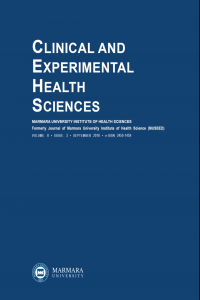Evaluation of Health Status of Turkish Ceramic Workers
Abstract
Objectives: The aim of this study was to evaluation of health status of Turkish
ceramic workers (n=99). For this purpose, leukocyte (WBC), hemoglobin (HGB),
haematocrit (HCT), thrombocyte (PLT), alanine aminotransferase (ALT), aspartate
aminotransferase (AST), creatinine (CR), arsenic (As) and mercury (Hg) levels
were investigated in workers and their controls (n=81). Also spirometry tests, chest
radiographs and workplace dust measurement were analyzed.
Methods: As and Hg levels determined by Inductively Coupled Plasma Mass
Spectrometry (ICP-MS). AST, ALT and CR levels were analyzed by Konelab Prime
60i auto-analyzer while Hb, PLT, WBC numbers and HCT percentages were
measured by Coulter LH780. Chest radiographs of workers were taken by using a
short exposure time with high voltage technique. Standard spirometry measurements
of workers and controls were done with a dry seal spirometry Dust samples were
collected with badge dosimeter and analyzed by gravimetrically.
Results: In this study, WBC, PLT, AST, ALT, CR, As and Hg levels of workers higher
while HGB and HCT levels lower than the controls. 38 workers were diagnosed with
silicosis, 9 workers were suspected to have silicosis, whereas 52 workers were found
to be healthy. Average value of FEV1/FVC ratios was found to be 81.430±5.314
(Mean ± SD) for workers and 81.31±5.22 (Mean ± SD) for controls. The mean
concentration of respirable total dust in workplace was 3.58 mg/m3
.Conclusion: Ceramic workers must be considered as risky persons as their working
conditions affect many organs and systems in their body such as liver, kidney and
hematopoetic system.
References
- Yassin A, Yebesi F, Tingle R. Occupational exposure to crystalline silica dust in the United States, 1988-2003. Environ. Health Perspect 2005; 113: 255-60.
Abstract
References
- Yassin A, Yebesi F, Tingle R. Occupational exposure to crystalline silica dust in the United States, 1988-2003. Environ. Health Perspect 2005; 113: 255-60.
Details
| Primary Language | English |
|---|---|
| Journal Section | Articles |
| Authors | |
| Publication Date | September 28, 2018 |
| Submission Date | June 20, 2017 |
| Published in Issue | Year 2018 Volume: 8 Issue: 3 |


